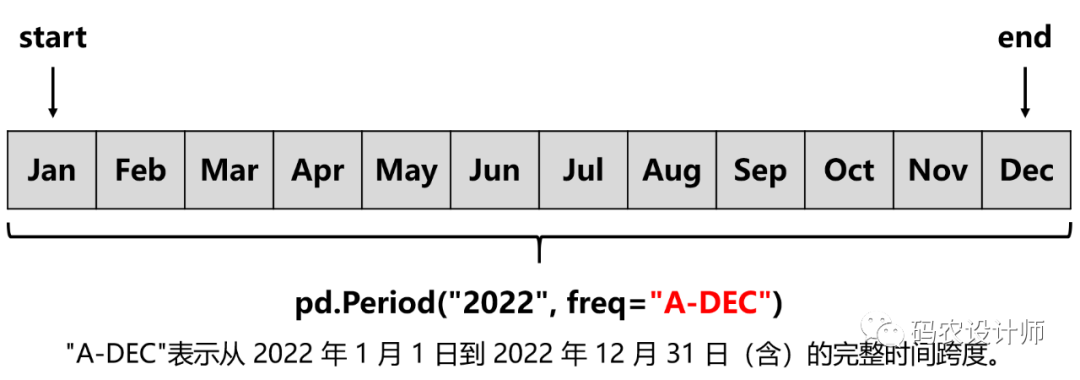本系列文章配套代码获取有以下三种途径:
-
可以在以下网站查看,该网站是使用JupyterLite搭建的web端Jupyter环境,因此无需在本地安装运行环境即可使用,首次运行浏览器需要下载一些配置文件(大约20M):
https://returu.github.io/Python_Data_Analysis/lab/index.html-
也可以通过百度网盘获取,需要在本地配置代码运行环境,环境配置可以查看【Python基础】2.搭建Python开发环境:
链接:https://pan.baidu.com/s/1MYkeYeVAIRqbxezQECHwcA?pwd=mnsj提取码:mnsj
-
前往GitHub详情页面,单击 code 按钮,选择Download ZIP选项:
https://github.com/returu/Python_Data_Analysis根据《Python for Data Analysis 3rd Edition》翻译整理
—————————————————–
时间区间表示的是时间范围,例如天、月、季度或年。pandas.Period 类表示此数据类型,需要使用一个字符串或数字以及有效的频率:
1# 在这种情况下,Period 对象表示从 2022 年 1 月 1 日到 2022 年 12 月 31 日(含)的完整时间跨度。
2>>> p = pd.Period("2022" , freq="A-DEC")
3>>> p
4Period('2022', 'A-DEC')
在时间段上增加或减去整数可以很方便的根据它们的频率进行移位:
1>>> p + 3
2Period('2025', 'A-DEC')
3
4>>> p - 2
5Period('2020', 'A-DEC')
果两个区间具有相同的频率,则它们的差值是它们之间的单位数:
1>>> pd.Period("2024", freq="A-DEC") - p
2<2 * YearEnds: month=12>
可以使用 period_range 函数构造规则的区间序列:
1>>> periods = pd.period_range("2022-1-1" , "2022-12-12" , freq="M")
2>>> periods
3PeriodIndex(['2022-01', '2022-02', '2022-03', '2022-04', '2022-05', '2022-06',
4 '2022-07', '2022-08', '2022-09', '2022-10', '2022-11', '2022-12'],
5 dtype='period[M]')
PeriodIndex 类存储的是区间的序列,可以作为任意pandas数据结构中的轴索引:
1>>> pd.Series(np.arange(len(periods)), index=periods)
22022-01 0
32022-02 1
42022-03 2
52022-04 3
62022-05 4
72022-06 5
82022-07 6
92022-08 7
102022-09 8
112022-10 9
122022-11 10
132022-12 11
14Freq: M, dtype: int32
如果你有一个字符串数组,也可以使用 PeriodIndex 类,它的所有值都是时间区间:
1>>> values = ["2001Q3", "2002Q2", "2003Q1"]
2
3>>> index = pd.PeriodIndex(values, freq="Q-DEC")
4>>> index
5PeriodIndex(['2001Q3', '2002Q2', '2003Q1'], dtype='period[Q-DEC]')
Periods 和 PeriodIndex 对象可以使用它们的 asfreq 方法将其转换为另一个频率。
例如,假设我们有一个年度区间,并希望在年初或年底将其转换为月度区间。可以这样做:
1# Period 对象表示从 2022 年 1 月 1 日到 2022 年 12 月 31 日(含)的完整时间跨度。
2>>> p = pd.Period("2022", freq="A-DEC")
3>>> p
4Period('2022', 'A-DEC')
5
6>>> p.asfreq("M",how="start")
7Period('2022-01', 'M')
8
9>>> p.asfreq("M",how="end")
10Period('2022-12', 'M')
11
12>>> p.asfreq("M")
13Period('2022-12', 'M')
区间频率转换示意图如下所示:

对于除了12月份以外的一个月结束的财政年度,相应的每月分期是不同的:
1>>> p = pd.Period("2022", freq="A-MAY")
2>>> p
3Period('2022', 'A-MAY')
4
5>>> p.asfreq("M",how="start")
6Period('2021-06', 'M')
7
8>>> p.asfreq("M",how="end")
9Period('2022-05', 'M')
区间频率转换示意图如下所示:

当你从高频转换为低频时,pandas会根据子区间的所属来决定父区间。
例如,在"A-MAY"频率中,"Aug-2021"是2022区间的一部分(可以参看上图分析):
1>>> p = pd.Period("Aug-2021", "M")
2
3>>> p.asfreq("A-MAY")
4Period('2022', 'A-MAY')
可以使用相同的语义转换完整的PeriodIndex 对象或时间序列。
例如,使用“M”频率,年度期间将被替换为对应于每个年度区间的第一个月的月度期间。
1>>> periods = pd.period_range("2019", "2022", freq="A-DEC")
2>>> periods
3PeriodIndex(['2019', '2020', '2021', '2022'], dtype='period[A-DEC]')
4
5>>> ts = pd.Series(np.arange(len(periods)), index=periods)
6>>> ts
72019 0
82020 1
92021 2
102022 3
11Freq: A-DEC, dtype: int32
12
13>>> ts.asfreq("M" , how="start")
142019-01 0
152020-01 1
162021-01 2
172022-01 3
18Freq: M, dtype: int32
此处,使用“B”频率表明我们想要的区间末端,年度区间将被替换为每年最后一个工作日:
1>>> ts.asfreq("B", how="end")
22019-12-31 0
32020-12-31 1
42021-12-31 2
52022-12-30 3
6Freq: B, dtype: int32
季度数据是会计、金融和其他领域的标准。许多季度数据是相对于财政年度结束报告的,通常是一年中 12 个月之一的最后一个日历日或工作日。
因此,2022Q4 期间根据财政年度结束具有不同的含义。pandas 支持所有 12 种可能的季度频率,从 Q-JAN 到 Q-DEC:
1>>> p = pd.Period("2022Q4", freq="Q-JAN")
2>>> p
3Period('2022Q4', 'Q-JAN')
对于在 1 月结束的财政年度,2022Q4 是从 2021 年 11 月到 2022 年 1 月,可以通过转换为每日频率来检查:
1>>> p.asfreq("D", how="start")
2Period('2021-11-01', 'D')
3
4>>> p.asfreq("D", how="end")
5Period('2022-01-31', 'D')
不同的季度频率示意图如下所示:

因此,可以进行简单的区间运算。
例如,获取在本季度的倒数第二个工作日下午 4 点的时间戳:
1>>> p4pm = (p.asfreq("B", how="end") - 1).asfreq("T", how="start") + 16 * 60
2>>> p4pm
3Period('2022-01-28 16:00', 'T')
4
5# to_timestamp 方法默认返回周期开始时的时间戳。
6>>> p4pm.to_timestamp()
7Timestamp('2022-01-28 16:00:00')
可以使用 pandas.period_range 生成季度序列,其算法也是相同的:
1>>> periods = pd.period_range("2021Q3", "2022Q4", freq="Q-JAN")
2>>> periods
3PeriodIndex(['2021Q3', '2021Q4', '2022Q1', '2022Q2', '2022Q3', '2022Q4'], dtype='period[Q-JAN]')
4
5>>> ts = pd.Series(np.arange(len(periods)), index=periods)
6>>> ts
72021Q3 0
82021Q4 1
92022Q1 2
102022Q2 3
112022Q3 4
122022Q4 5
13Freq: Q-JAN, dtype: int32
14
15>>> new_periods = (periods.asfreq("B", "end") - 1).asfreq("H", "start") + 16
16>>> new_periods
17PeriodIndex(['2020-10-29 16:00', '2021-01-28 16:00', '2021-04-29 16:00',
18 '2021-07-29 16:00', '2021-10-28 16:00', '2022-01-28 16:00'],
19 dtype='period[H]')
20
21>>> ts.index = new_periods.to_timestamp()
22
23>>> ts
242020-10-29 16:00:00 0
252021-01-28 16:00:00 1
262021-04-29 16:00:00 2
272021-07-29 16:00:00 3
282021-10-28 16:00:00 4
292022-01-28 16:00:00 5
30dtype: int32
本篇文章来源于微信公众号: 码农设计师
